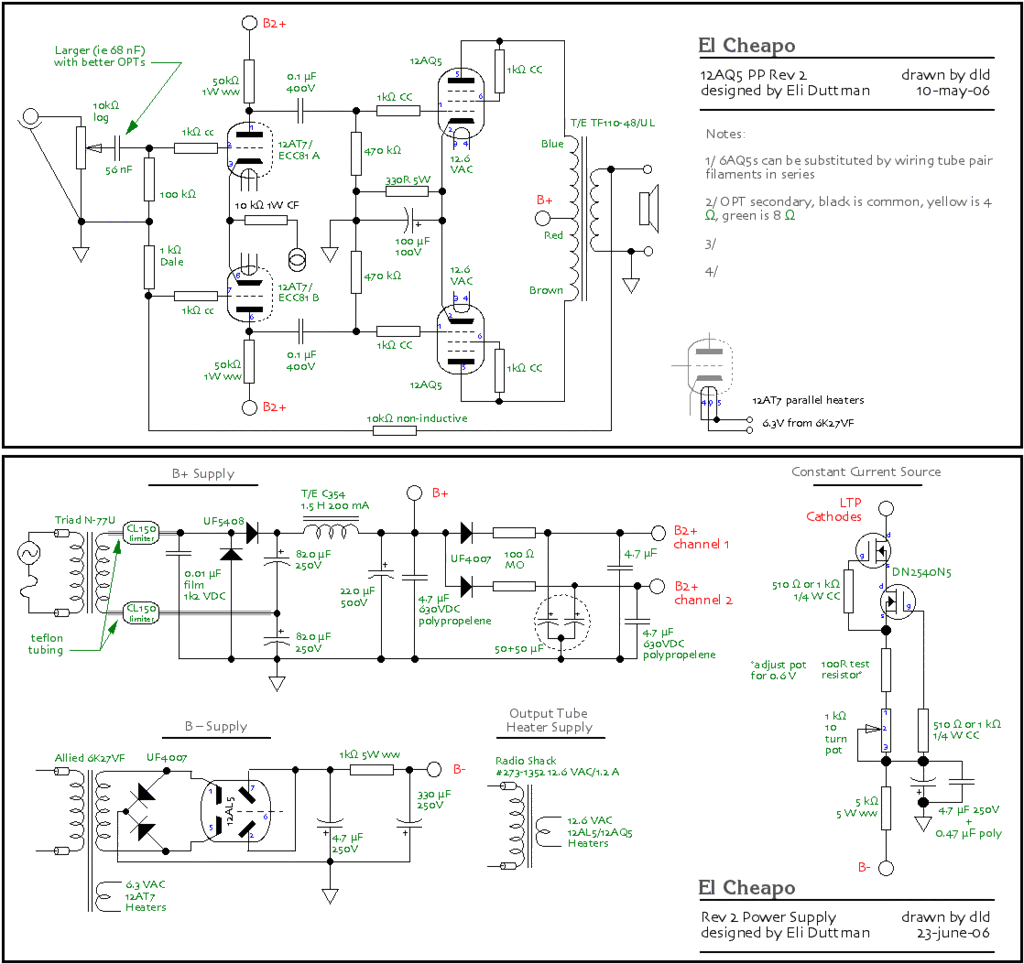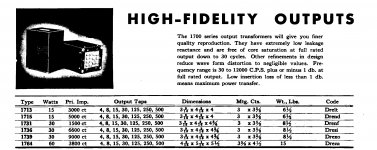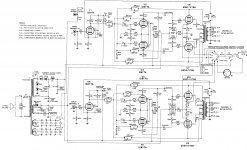Suggestions and circuits requested please...
Pair of Hammond 1739 from 1950s-60s era
Specs are 9k P-P primary (no ultralinear windings) to 4/8/15/30/125/250/500, 30 Watts
Looking for a robust simple HiFi circuit, clean sound, long continuous service, low maintenance. Will probably buy new Hammond Power transformer(s) and chassis for this project...
First thought was both channels on the same chassis, using EL84s for outputs, and something like the 272HX (600VCT @ 230mA, 5V@3A, 6.3V@6A) for power...
Then I thought maybe a nice pair of 5881 monoblocks (I have a bunch of 5881s, also some nice NOS Hammond 12"x8" chassis cages)... move the secondary taps over so I get a 4.5k primary, and use something like a Hammond 274X (750VCT @ 126mA, 5V@3A, 6.3V@5A) for each pair...
What would you do?
Pair of Hammond 1739 from 1950s-60s era
Specs are 9k P-P primary (no ultralinear windings) to 4/8/15/30/125/250/500, 30 Watts
An externally hosted image should be here but it was not working when we last tested it.
An externally hosted image should be here but it was not working when we last tested it.
Looking for a robust simple HiFi circuit, clean sound, long continuous service, low maintenance. Will probably buy new Hammond Power transformer(s) and chassis for this project...
First thought was both channels on the same chassis, using EL84s for outputs, and something like the 272HX (600VCT @ 230mA, 5V@3A, 6.3V@6A) for power...
Then I thought maybe a nice pair of 5881 monoblocks (I have a bunch of 5881s, also some nice NOS Hammond 12"x8" chassis cages)... move the secondary taps over so I get a 4.5k primary, and use something like a Hammond 274X (750VCT @ 126mA, 5V@3A, 6.3V@5A) for each pair...
What would you do?
use the higher secondary taps and build whatever you like...
these may or may not have good frequency response... you'll have to try them and see.
_-_-
these may or may not have good frequency response... you'll have to try them and see.
_-_-
Third possibility: pentode output stage with sweep tubes and a high B+. See Pete Millett's "Engineer's Amp" for one good example.
Suggestions and circuits requested please...
Pair of Hammond 1739 from 1950s-60s era
Specs are 9k P-P primary (no ultralinear windings) to 4/8/15/30/125/250/500, 30 Watts
Have a look at this: STC 807 Application report. These OPTs were definitely made for PP 807s operating Class AB1 with cathode bias. (If for fixed bias, the primaries would be 6K6 (P-2-P) ).
Looking for a robust simple HiFi circuit, clean sound, long continuous service, low maintenance. Will probably buy new Hammond Power transformer(s) and chassis for this project...
You shouldn't have any difficulties coming up with any number of designs for PP Class AB1, cathode bias, 6L6s or other 6L6-oids like the 807, 1625, 6BG6. All those types are electronically identical; they just come in different packages.
Just make sure you include screen regulation, and local NFB. That lNFB could be done with parallel feedback, but with the plethora of secondary tap-offs, cathode lNFB becomes a definite possibility. All you need to do is connect your load between the secondary's common, and the 2X tap. The 0.5X tap becomes your secondary center tap and the DC return for the cathodes. How you connect the cathodes determines whether you have positive feedback (bad) or negative feedback (good). Once you have the lNFB sorted out, all you require is enough additional gNFB to take the "edge" off.
The type tends to make nasty high order harmonics without lNFB, and snivets without screen stoppers (~1.0K is good). Plate stoppers consisting of a space wound coil (ID= 7/16th in; N= 10; #18 AWG) paralleled with a 100R/2W C-comp resistor (or four 470R/0.5W C-comps in parallel) mounted inside the coil, and connected at the plate connection is also advisable, as the type can make RF.
If done right, the 6L6-oids give excellent sonic performance. I've designed with the type, though I opted for fixed bias instead of cathode bias, and parallel lNFB instead of cathode lNFB (the extra secondary tap-offs being unavailable). The current demand isn't so extreme that you couldn't make two stereo channels on the same chassis.
Anyway, that's what I'd use 'em for. The Z-transformation ratio is way too much for the horizontal deflection types, which pull heavier currents, and like smaller plate loads. Some vertical deflection types might be a possibility. Perhaps something like the 6LR8 (though this type also seems to do best with a somewhat smaller 6K6 (P-2-P) load)?
With those secondaries the first thing that came to mind was something like this amp with added switchable headphone outputs.
Looking at the "data sheet" I wondered though. Enough bandwidth for you? Maybe best to start with what you have on hand and see what they do? Differential 5881?
Looking at the "data sheet" I wondered though. Enough bandwidth for you? Maybe best to start with what you have on hand and see what they do? Differential 5881?
Attachments
With OPT's, isn't it true that the less plate current you put through them, the greater the apparent primary inductance, so the better the bass performance?
Also, if you have less plate current, the better the bandwidth on the high frequency end, too?
If yes, then what about PP 6V6-triodes for only about 5 watts per channel (class A)? Very linear when used that way, easy to drive. Eli Duttman's El Cheapo would be a possibility.

Also, Poinz' Musical Machine with EL34-triode outs:
http://www.diyaudio.com/forums/tubes-valves/136562-pp-el34-6l6-circuits.html#post1713636
He uses a 5k:VC OPT because it's fixed bias. You could go cathode bias for the EL34-triodes and your 9k OPT's.
I think the original version was PP 6V6-triode...
--
Also, if you have less plate current, the better the bandwidth on the high frequency end, too?
If yes, then what about PP 6V6-triodes for only about 5 watts per channel (class A)? Very linear when used that way, easy to drive. Eli Duttman's El Cheapo would be a possibility.

Also, Poinz' Musical Machine with EL34-triode outs:
http://www.diyaudio.com/forums/tubes-valves/136562-pp-el34-6l6-circuits.html#post1713636
He uses a 5k:VC OPT because it's fixed bias. You could go cathode bias for the EL34-triodes and your 9k OPT's.
I think the original version was PP 6V6-triode...
--
Last edited:
Thanks everyone for your suggestions, some very interesting ideas.
I think I'm going to start with a pair of monoblocks in PP Class AB1, cathode biased 6L6/5881, keep the plates under 400V, and look into experimenting with feedback.
I think I'm going to start with a pair of monoblocks in PP Class AB1, cathode biased 6L6/5881, keep the plates under 400V, and look into experimenting with feedback.
That lNFB could be done with parallel feedback
What is INFB? Is there an example schematic anyone can point me to that uses this type of feedback?
What is INFB? Is there an example schematic anyone can point me to that uses this type of feedback?
lNFB: Local negative feedback -- the output of the finals is fed back into the grid circuit, or at least not more than a gain stage behind the finals.
I did a design using 807s that incorporates this feedback implementation. R33 and R34 are the lNFB divider resistors (C9 and C10 are DC isolation capacitors). These, in combination with the impedance at the node formed by the plate loads of the 6SL7s and the DC return resistor of the 6SN7 cathode followers is the remaining divider resistance: this being:
Rp || r_p || Rg
Since the calculated r_p= 73K8 at the Q-Point of the 6SL7s, that becomes:
220E3 || 73.8E3 || 1.0E6= 52.4E3
Since the Schade white paper recommends feeding back 10% of the plate voltage, that establishes Rf:
Rf= 9 X 52.4E3= 471.31E3 (Select Rf= 470K design nominal value)
You also have to take into account the extra load this presents to the previous stage. In this case, it makes the effective plate load for the 6SL7s look like 144K. Redrawing the loadline on that basis gives a stage gain of 50, for Av= 25 for the LTP, designed measured, for 0% error. 😀
It works, and the lNFB recommend was spot on. Sounds great, and a much needed improvement over open loop performance.
Awesome answer guys, thanks. Appears I misread the first letter in the "lNFB" It's an "L", not an "I".
By the way, if others reading this aren't familiar, I believe Miles is describing his Vixen 807 amp design in post #10.
By the way, if others reading this aren't familiar, I believe Miles is describing his Vixen 807 amp design in post #10.
Awesome answer guys, thanks. Appears I misread the first letter in the "lNFB" It's an "L", not an "I".
By the way, if others reading this aren't familiar, I believe Miles is describing his Vixen 807 amp design in post #10.
That's what I was describing. For some reason, the attachment didn't take. So let's try again.
Attachments
Well, with these transformers at 15W / 9K pl-to-pl, I would use a pair of 6V6 and stay at 12-15Wrms maximum output (plate voltage circa 350VDC). To use 6L6 or 5881 you would need 5K to 6K6 pl-to-pl. That's what I used here on my 10W class A/AB1 compact mono units :
A+!
An externally hosted image should be here but it was not working when we last tested it.
An externally hosted image should be here but it was not working when we last tested it.
An externally hosted image should be here but it was not working when we last tested it.
A+!
- Status
- Not open for further replies.
- Home
- Amplifiers
- Tubes / Valves
- What would you build with these output transformers?


